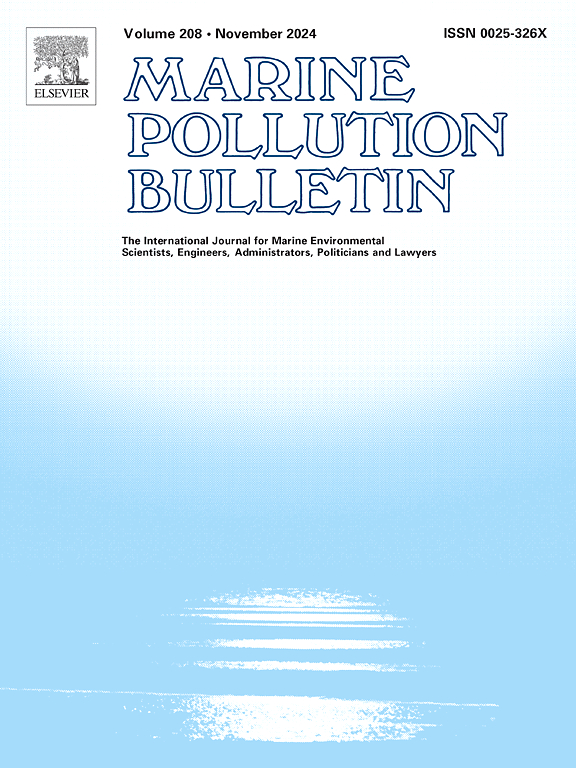Modeling the potential source routes of marine macroplastics on a beach adjacent to the Patos lagoon estuary, South Brazil
IF 4.9
3区 环境科学与生态学
Q1 ENVIRONMENTAL SCIENCES
引用次数: 0
Abstract
Cassino Beach, on the southernmost coast of Brazil, is especially vulnerable to plastic pollution due to its 220 km-long coastline and proximity to the Patos Lagoon Estuary, which is influenced by urbanization, industrial activities, and intense coastal fishing. This study investigates the aquatic origin (lagoon or ocean) of stranded macroplastics during the summer and winter of 2016 at two sites: one located 3–5 km from the estuary mouth and another approximately 40 km away. A backward particle tracking approach was applied, combining the TELEMAC-3D hydrodynamic model with the TrackMPD model. Model validation using a buoy experiment showed a maximum difference of <500 m between real and virtual particle trajectories. A total of 100 virtual particles (0.8 m LDPE sheets, ρ = 0.94 g·cm−3) were released per site and season. At the near-estuary site (S1), most particles (75 % in summer, 68 % in winter) originated from the central region of Patos Lagoon, while an additional 6 % (summer) to 25 % (winter) came from the São Gonçalo Channel. At the remote site (S4), particles mainly originated from marine regions: 98 % (winter) and 43 % (summer: 30 % SW + 13 % NE coastal domain) Simulated transport times ranged from 4.7 to 83 days, with shorter durations during winter due to stronger coastal currents. These results highlight the dominant role of estuarine outflow in transporting macroplastics to areas near the Patos Lagoon mouth, whereas remote areas are influenced by long-distance marine transport, particularly from fishing zones. The integration of numerical modeling with field data is the main contribution of this study to improve our understanding of debris sources and support more effective management strategies.
模拟巴西南部帕托斯泻湖河口附近海滩上海洋宏观塑料的潜在来源路线
卡西诺海滩位于巴西最南端的海岸,由于其220公里长的海岸线和靠近帕托斯泻湖河口,受城市化、工业活动和沿海捕捞活动的影响,特别容易受到塑料污染的影响。本研究调查了2016年夏季和冬季两个地点搁浅的巨塑料的水生来源(泻湖或海洋):一个位于离河口3-5公里处,另一个位于约40公里处。将TELEMAC-3D流体动力学模型与TrackMPD模型相结合,采用了一种反向粒子跟踪方法。通过浮标实验验证的模型表明,真实粒子轨迹与虚拟粒子轨迹之间的最大差异为500 m。每个地点和季节共释放100个虚拟粒子(0.8 m LDPE片,ρ = 0.94 g·cm−3)。在近河口位置(S1),大部分颗粒(夏季占75%,冬季占68%)来自帕托斯泻湖中部地区,另有6%(夏季)至25%(冬季)来自 o gon拉萨洛海峡。在偏远地区(S4),颗粒主要来自海洋区域:98%(冬季)和43%(夏季:30% SW + 13% NE沿海区)模拟运输时间在4.7 ~ 83天之间,冬季由于沿海流较强,持续时间较短。这些结果强调了河口外流在将宏观塑料运输到帕托斯泻湖口附近地区方面的主导作用,而偏远地区则受到远距离海洋运输的影响,特别是来自渔区的海洋运输。将数值模拟与现场数据相结合是本研究的主要贡献,有助于提高我们对碎屑来源的理解,并支持更有效的管理策略。
本文章由计算机程序翻译,如有差异,请以英文原文为准。
求助全文
约1分钟内获得全文
求助全文
来源期刊

Marine pollution bulletin
环境科学-海洋与淡水生物学
CiteScore
10.20
自引率
15.50%
发文量
1077
审稿时长
68 days
期刊介绍:
Marine Pollution Bulletin is concerned with the rational use of maritime and marine resources in estuaries, the seas and oceans, as well as with documenting marine pollution and introducing new forms of measurement and analysis. A wide range of topics are discussed as news, comment, reviews and research reports, not only on effluent disposal and pollution control, but also on the management, economic aspects and protection of the marine environment in general.
 求助内容:
求助内容: 应助结果提醒方式:
应助结果提醒方式:


